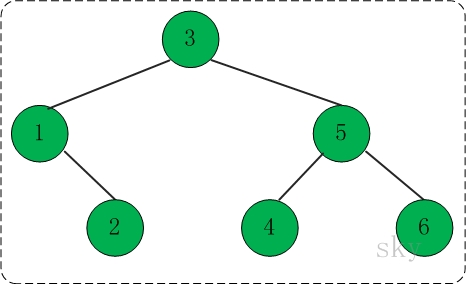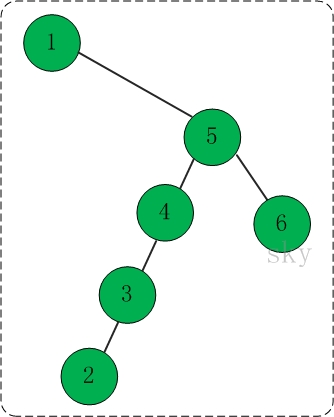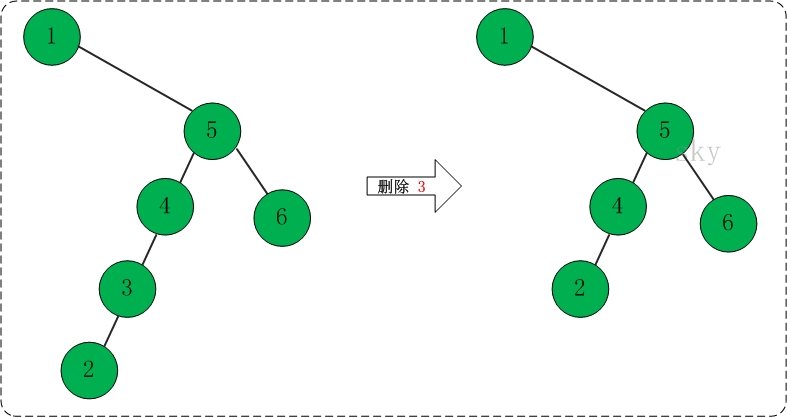上一章介绍了"二叉查找树的相关理论知识,并通过C语言实现了二叉查找树"。这一章给出二叉查找树的C++版本。这里不再对树的相关概念进行介绍,若遇到不明白的概念,可以在上一章查找。
第1部分 二叉查找树简介
二叉查找树(Binary Search Tree),又被称为二叉搜索树。
它是特殊的二叉树:对于二叉树,假设x为二叉树中的任意一个结点,x节点包含关键字key,节点x的key值记为key[x]。如果y是x的左子树中的一个结点,则key[y] <= key[x];如果y是x的右子树的一个结点,则key[y] >= key[x]。那么,这棵树就是二叉查找树。如下图所示:
在二叉查找树中:
(01) 若任意节点的左子树不空,则左子树上所有结点的值均小于它的根结点的值;
(02) 任意节点的右子树不空,则右子树上所有结点的值均大于它的根结点的值;
(03) 任意节点的左、右子树也分别为二叉查找树。
(04) 没有键值相等的节点(no duplicate nodes)。
第2部分 二叉查找树的C++实现
1. 节点和二叉查找树的定义
1.1 二叉查找树节点
template <class T>
class BSTNode{
public:
T key; // 关键字(键值)
BSTNode *left; // 左孩子
BSTNode *right; // 右孩子
BSTNode *parent;// 父结点
BSTNode(T value, BSTNode *p, BSTNode *l, BSTNode *r):
key(value),parent(),left(l),right(r) {}
};
BSTNode是二叉查找树的节点,它包含二叉查找树的几个基本信息:
(01) key -- 它是关键字,是用来对二叉查找树的节点进行排序的。
(02) left -- 它指向当前节点的左孩子。
(03) right -- 它指向当前节点的右孩子。
(04) parent -- 它指向当前节点的父结点。
1.2 二叉树操作
template <class T>
class BSTree {
private:
BSTNode<T> *mRoot; // 根结点
public:
BSTree();
~BSTree();
// 前序遍历"二叉树"
void preOrder();
// 中序遍历"二叉树"
void inOrder();
// 后序遍历"二叉树"
void postOrder();
// (递归实现)查找"二叉树"中键值为key的节点
BSTNode<T>* search(T key);
// (非递归实现)查找"二叉树"中键值为key的节点
BSTNode<T>* iterativeSearch(T key);
// 查找最小结点:返回最小结点的键值。
T minimum();
// 查找最大结点:返回最大结点的键值。
T maximum();
// 找结点(x)的后继结点。即,查找"二叉树中数据值大于该结点"的"最小结点"。
BSTNode<T>* successor(BSTNode<T> *x);
// 找结点(x)的前驱结点。即,查找"二叉树中数据值小于该结点"的"最大结点"。
BSTNode<T>* predecessor(BSTNode<T> *x);
// 将结点(key为节点键值)插入到二叉树中
void insert(T key);
// 删除结点(key为节点键值)
void remove(T key);
// 销毁二叉树
void destroy();
// 打印二叉树
void print();
private:
// 前序遍历"二叉树"
void preOrder(BSTNode<T>* tree) const;
// 中序遍历"二叉树"
void inOrder(BSTNode<T>* tree) const;
// 后序遍历"二叉树"
void postOrder(BSTNode<T>* tree) const;
// (递归实现)查找"二叉树x"中键值为key的节点
BSTNode<T>* search(BSTNode<T>* x, T key) const;
// (非递归实现)查找"二叉树x"中键值为key的节点
BSTNode<T>* iterativeSearch(BSTNode<T>* x, T key) const;
// 查找最小结点:返回tree为根结点的二叉树的最小结点。
BSTNode<T>* minimum(BSTNode<T>* tree);
// 查找最大结点:返回tree为根结点的二叉树的最大结点。
BSTNode<T>* maximum(BSTNode<T>* tree);
// 将结点(z)插入到二叉树(tree)中
void insert(BSTNode<T>* &tree, BSTNode<T>* z);
// 删除二叉树(tree)中的结点(z),并返回被删除的结点
BSTNode<T>* remove(BSTNode<T>* &tree, BSTNode<T> *z);
// 销毁二叉树
void destroy(BSTNode<T>* &tree);
// 打印二叉树
void print(BSTNode<T>* tree, T key, int direction);
};
BSTree是二叉树。它包含二叉查找树的根节点和二叉查找树的操作。二叉查找树的操作中有许多重载函数,例如insert()函数,其中一个是内部接口,另一个是提供给外部的接口。
2 遍历
这里讲解前序遍历、中序遍历、后序遍历3种方式。
2.1 前序遍历
若二叉树非空,则执行以下操作:
(01) 访问根结点;
(02) 先序遍历左子树;
(03) 先序遍历右子树。
前序遍历代码
template <class T>
void BSTree<T>::preOrder(BSTNode<T>* tree) const
{
if(tree != NULL)
{
cout<< tree->key << " " ;
preOrder(tree->left);
preOrder(tree->right);
}
}
template <class T>
void BSTree<T>::preOrder()
{
preOrder(mRoot);
}
2.2 中序遍历
若二叉树非空,则执行以下操作:
(01) 中序遍历左子树;
(02) 访问根结点;
(03) 中序遍历右子树。
中序遍历代码
template <class T>
void BSTree<T>::inOrder(BSTNode<T>* tree) const
{
if(tree != NULL)
{
inOrder(tree->left);
cout<< tree->key << " " ;
inOrder(tree->right);
}
}
template <class T>
void BSTree<T>::inOrder()
{
inOrder(mRoot);
}
2.3 后序遍历
若二叉树非空,则执行以下操作:
(01) 后序遍历左子树;
(02) 后序遍历右子树;
(03) 访问根结点。
后序遍历代码
template <class T>
void BSTree<T>::postOrder(BSTNode<T>* tree) const
{
if(tree != NULL)
{
postOrder(tree->left);
postOrder(tree->right);
cout<< tree->key << " " ;
}
}
template <class T>
void BSTree<T>::postOrder()
{
postOrder(mRoot);
}
看看下面这颗树的各种遍历方式:

对于上面的二叉树而言,
(01) 前序遍历结果: 3 1 2 5 4 6
(02) 中序遍历结果: 1 2 3 4 5 6
(03) 后序遍历结果: 2 1 4 6 5 3
3. 查找
递归版本的代码
template <class T>
BSTNode<T>* BSTree<T>::search(BSTNode<T>* x, T key) const
{
if (x==NULL || x->key==key)
return x;
if (key < x->key)
return search(x->left, key);
else
return search(x->right, key);
}
template <class T>
BSTNode<T>* BSTree<T>::search(T key)
{
search(mRoot, key);
}
非递归版本的代码
template <class T>
BSTNode<T>* BSTree<T>::iterativeSearch(BSTNode<T>* x, T key) const
{
while ((x!=NULL) && (x->key!=key))
{
if (key < x->key)
x = x->left;
else
x = x->right;
}
return x;
}
template <class T>
BSTNode<T>* BSTree<T>::iterativeSearch(T key)
{
iterativeSearch(mRoot, key);
}
4. 最大值和最小值
查找最大值的代码
template <class T>
BSTNode<T>* BSTree<T>::maximum(BSTNode<T>* tree)
{
if (tree == NULL)
return NULL;
while(tree->right != NULL)
tree = tree->right;
return tree;
}
template <class T>
T BSTree<T>::maximum()
{
BSTNode<T> *p = maximum(mRoot);
if (p != NULL)
return p->key;
return (T)NULL;
}
查找最小值的代码
template <class T>
BSTNode<T>* BSTree<T>::minimum(BSTNode<T>* tree)
{
if (tree == NULL)
return NULL;
while(tree->left != NULL)
tree = tree->left;
return tree;
}
template <class T>
T BSTree<T>::minimum()
{
BSTNode<T> *p = minimum(mRoot);
if (p != NULL)
return p->key;
return (T)NULL;
}
5. 前驱和后继
节点的前驱:是该节点的左子树中的最大节点。
节点的后继:是该节点的右子树中的最小节点。
查找前驱节点的代码
/*
* 找结点(x)的前驱结点。即,查找"二叉树中数据值小于该结点"的"最大结点"。
*/
template <class T>
BSTNode<T>* BSTree<T>::predecessor(BSTNode<T> *x)
{
// 如果x存在左孩子,则"x的前驱结点"为 "以其左孩子为根的子树的最大结点"。
if (x->left != NULL)
return maximum(x->left);
// 如果x没有左孩子。则x有以下两种可能:
// (01) x是"一个右孩子",则"x的前驱结点"为 "它的父结点"。
// (01) x是"一个左孩子",则查找"x的最低的父结点,并且该父结点要具有右孩子",找到的这个"最低的父结点"就是"x的前驱结点"。
BSTNode<T>* y = x->parent;
while ((y!=NULL) && (x==y->left))
{
x = y;
y = y->parent;
}
return y;
}
查找后继节点的代码
/*
* 找结点(x)的后继结点。即,查找"二叉树中数据值大于该结点"的"最小结点"。
*/
template <class T>
BSTNode<T>* BSTree<T>::successor(BSTNode<T> *x)
{
// 如果x存在右孩子,则"x的后继结点"为 "以其右孩子为根的子树的最小结点"。
if (x->right != NULL)
return minimum(x->right);
// 如果x没有右孩子。则x有以下两种可能:
// (01) x是"一个左孩子",则"x的后继结点"为 "它的父结点"。
// (02) x是"一个右孩子",则查找"x的最低的父结点,并且该父结点要具有左孩子",找到的这个"最低的父结点"就是"x的后继结点"。
BSTNode<T>* y = x->parent;
while ((y!=NULL) && (x==y->right))
{
x = y;
y = y->parent;
}
return y;
}
6. 插入
插入节点的代码
/*
* 将结点插入到二叉树中
*
* 参数说明:
* tree 二叉树的根结点
* z 插入的结点
*/
template <class T>
void BSTree<T>::insert(BSTNode<T>* &tree, BSTNode<T>* z)
{
BSTNode<T> *y = NULL;
BSTNode<T> *x = tree;
// 查找z的插入位置
while (x != NULL)
{
y = x;
if (z->key < x->key)
x = x->left;
else
x = x->right;
}
z->parent = y;
if (y==NULL)
tree = z;
else if (z->key < y->key)
y->left = z;
else
y->right = z;
}
/*
* 将结点(key为节点键值)插入到二叉树中
*
* 参数说明:
* tree 二叉树的根结点
* key 插入结点的键值
*/
template <class T>
void BSTree<T>::insert(T key)
{
BSTNode<T> *z=NULL;
// 如果新建结点失败,则返回。
if ((z=new BSTNode<T>(key,NULL,NULL,NULL)) == NULL)
return ;
insert(mRoot, z);
}
注:本文实现的二叉查找树是允许插入相同键值的节点的。若想禁止二叉查找树中插入相同键值的节点,可以参考"二叉查找树(一)之 图文解析 和 C语言的实现"中的插入函数进行修改。
7. 删除
删除节点的代码
/*
* 删除结点(z),并返回被删除的结点
*
* 参数说明:
* tree 二叉树的根结点
* z 删除的结点
*/
template <class T>
BSTNode<T>* BSTree<T>::remove(BSTNode<T>* &tree, BSTNode<T> *z)
{
BSTNode<T> *x=NULL;
BSTNode<T> *y=NULL;
if ((z->left == NULL) || (z->right == NULL) )
y = z;
else
y = successor(z);
if (y->left != NULL)
x = y->left;
else
x = y->right;
if (x != NULL)
x->parent = y->parent;
if (y->parent == NULL)
tree = x;
else if (y == y->parent->left)
y->parent->left = x;
else
y->parent->right = x;
if (y != z)
z->key = y->key;
return y;
}
/*
* 删除结点(z),并返回被删除的结点
*
* 参数说明:
* tree 二叉树的根结点
* z 删除的结点
*/
template <class T>
void BSTree<T>::remove(T key)
{
BSTNode<T> *z, *node;
if ((z = search(mRoot, key)) != NULL)
if ( (node = remove(mRoot, z)) != NULL)
delete node;
}
8. 打印
打印二叉查找树的代码
/*
* 打印"二叉查找树"
*
* key -- 节点的键值
* direction -- 0,表示该节点是根节点;
* -1,表示该节点是它的父结点的左孩子;
* 1,表示该节点是它的父结点的右孩子。
*/
template <class T>
void BSTree<T>::print(BSTNode<T>* tree, T key, int direction)
{
if(tree != NULL)
{
if(direction==0) // tree是根节点
cout << setw(2) << tree->key << " is root" << endl;
else // tree是分支节点
cout << setw(2) << tree->key << " is " << setw(2) << key << "'s " << setw(12) << (direction==1?"right child" : "left child") << endl;
print(tree->left, tree->key, -1);
print(tree->right,tree->key, 1);
}
}
template <class T>
void BSTree<T>::print()
{
if (mRoot != NULL)
print(mRoot, mRoot->key, 0);
}
9. 销毁
销毁二叉查找树的代码
/*
* 销毁二叉树
*/
template <class T>
void BSTree<T>::destroy(BSTNode<T>* &tree)
{
if (tree==NULL)
return ;
if (tree->left != NULL)
return destroy(tree->left);
if (tree->right != NULL)
return destroy(tree->right);
delete tree;
tree=NULL;
}
template <class T>
void BSTree<T>::destroy()
{
destroy(mRoot);
}
第3部分 二叉查找树的C++实现(完整源码)
点击查看:源代码
关于二叉查找树的C++实现有两点需要补充说明的:
第1点:采用了STL模板。因此,二叉查找树支持任意数据类型。
第2点:将二叉查找树的"声明"和"实现"都位于BSTree.h中。这是因为,在二叉查找树的实现采用了模板;而C++编译器不支持对模板的分离式编译!
上面的BSTreeTest.cpp是二叉查找树树的测试程序,运行结果如下:
== 依次添加: 1 5 4 3 2 6
== 前序遍历: 1 5 4 3 2 6
== 中序遍历: 1 2 3 4 5 6
== 后序遍历: 2 3 4 6 5 1
== 最小值: 1
== 最大值: 6
== 树的详细信息:
1 is root
5 is 1's right child
4 is 5's left child
3 is 4's left child
2 is 3's left child
6 is 5's right child
== 删除根节点: 3
== 中序遍历: 1 2 4 5 6
下面对测试程序的流程进行分析!
(01) 新建"二叉查找树"root。
(02) 向二叉查找树中依次插入1,5,4,3,2,6 。如下图所示:

(03) 打印树的信息
插入1,5,4,3,2,6之后,得到的二叉查找树如下:

前序遍历结果: 1 5 4 3 2 6
中序遍历结果: 1 2 3 4 5 6
后序遍历结果: 2 3 4 6 5 1
最小值是1,而最大值是6。
(04) 删除节点3。如下图所示:

(05) 重新遍历该二叉查找树。
中序遍历结果: 1 2 4 5 6